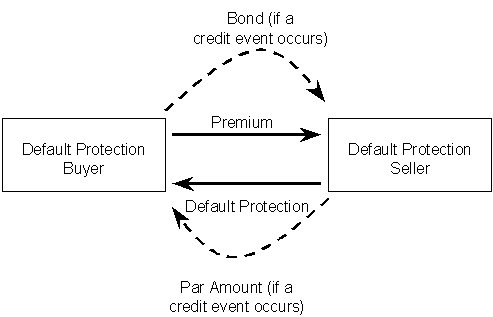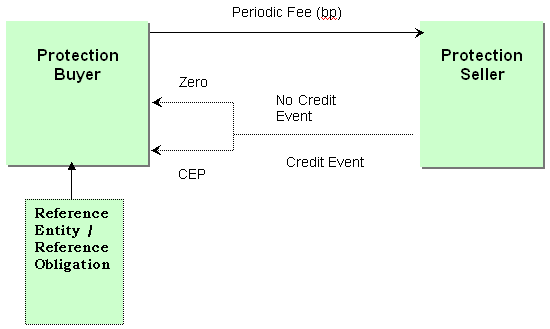Project Map
Back to First-Page to View Table of
Contents
|
[Source: Report of RBI Working Group on Credit Derivatives]
Credit Default Swaps
Introduction
The credit default swaps (CDS) have grown rapidly in the credit risk market since their introduction in the early 1990s. It is believed that current usage is but a small fraction of what it will ultimately represent in the credit risk markets. In particular, the CDS market will become as central to the management of credit risk as the interest rate swap market is to the management of market risk.
Description
In a CDS, as shown below in Figure 1, one party agrees to pay another party periodic fixed payments in exchange for receiving "credit event protection", in the form of a payment, in the event that a third party or its obligations are subject to one or more pre-agreed adverse credit events over a pre-agreed time period. Typical credit events include bankruptcy, failure to pay, obligation acceleration, restructuring, and repudiation/moratorium. With few exceptions, the legal framework of a CDS - that is, the documentation evidencing the transaction - is based on a confirmation document and legal definitions set forth by the International Swaps and Derivatives Association, Inc. (ISDA). It is the CDS market's convention to refer to the party that makes the periodic payments for credit event protection as the Protection Buyer. Conversely, the party that provides the credit event protection is referred to as the Protection Seller. The third party and the specific obligation, if any, on which credit event protection is concurrently bought and sold are referred to as the Reference Entity and Reference Obligation, respectively. 
Physically Settled Credit Default Swap
In most instances, the Protection Buyer makes quarterly payments to the Protection Seller. The periodic payment is typically expressed in annualized basis points of a transaction's notional amount. In the instance that no pre-specified credit event occurs during the life of the transaction, the Protection Seller receives the periodic payment in compensation for assuming the credit risk on the Reference Entity/Obligation. Conversely, in the instance that any one of the credit events occurs during the life of the transaction, the Protection Buyer will receive a compensating payment. The form of the compensation will depend on whether the terms of a particular CDS calls for a physical or cash settlement. In a physically settled transaction, the buyer of protection would deliver the reference obligation (or an obligation of equal or higher payment priority) to the Protection Seller and receive the face value of the Reference Obligation. Alternatively, in a cash settled transaction, the Protection Seller makes a cash payment to the Protection Buyer based on a formula that the two parties agree upon at the inception of the contract. Generally, the formula specifies that the Protection Seller pays the Protection Buyer the difference between par and the then prevailing market value of a Reference Obligation following one of the specified credit events. In some cases, the cash payment is a fixed amount decided at the inception of the contract. Figure 2 pictorially shows the transactions under a cash settled CDS. 
Cash Settled Credit Default Swaps
CEP refers to Credit Event Payment.
Thus, the CDS is a swap transaction under which:
On start date, no payments are made by either party; and On periodic interim dates, Protection Buyer pays to Protection Seller pre-agreed amounts; and If a Credit Event does not occur, no further payments are made at maturity; or If a Credit Event occurs and physical settlement applies, the transaction shall accelerate and Protection Buyer shall deliver the Deliverable Obligations (defined below) to Protection Seller against payment of a pre-agreed amount; or If a Credit Event occurs and cash settlement applies, the transaction shall accelerate and Protection Seller shall pay to Protection Buyer the excess of (a) the par value of the Deliverable Obligations on start date over (b) the prevailing market value of the Deliverable Obligations upon occurrence of the Credit Event. (The procedure for determining market value of Deliverable Obligations is defined in the ISDA definitions or may be defined in the related Confirmation), or a pre-determined amount agreed by both parties on inception of the transaction.
Characteristics of Credit Default Swap
Transforms asset specific credit risk to reference entity risk Contingent settlement, which is triggered by a Credit Event, can be calculated in several ways. Settlement options include:
physical delivery of Reference Obligation (or other Deliverable Obligations) in exchange for par value cash settlement equal to [(Par - Recovery Value) * notional] cash settlement equal to an agreed % of notional e.g. 50% of the notional of the transaction. "Deliverable Obligations" defines what assets are eligible for delivery as settlement in a physical delivery contract. Usually includes Reference Obligation but will often be broader to include other Obligations "Obligations" defines what assets may trigger a Credit Event
Uses and Benefits of Credit Default Swaps
Effective tool for hedging against changes in Credit Spreads - Default swaps are dynamic, market-sensitive products whose mark-to-market performance is closely related to changes in credit spreads. As a result, they are an effective tool for hedging (or for assuming exposure to) changes in credit spread as well as default risk.
Ability to create custom maturity products - An investor wants a three-year maturity and duration exposure to an issuer that has only 2-year and 10-year securities outstanding. Selling a three-year Default Swap on the 10-year security can create the required exposure. In effect, the investor will have taken on the credit risk for the duration of the swap, i.e. 3 years. Management of concentration of credit risk within credit portfolios - An investor who owns a portfolio of credits can alter the concentration risk of their portfolio by buying or selling credit risk on different names and varying maturities by using credit default swaps. Management of credit limits - For banks that have loans or transactions with counterparties that require further funding but are constrained because of internal or regulatory credit limits, credit default swaps can allow the bank to reduce the credit exposure to that counterparty without damaging the business relationship
Pricing of CDS
CDS premium quotations are typically in basis points per year. The cash market equivalent would be the credit spread over Government bonds at which a given corporate trades, e.g. 200 basis points over 5 year Govt of India bonds.
If a counterparty seeks to go short credit risk (i.e. to sell protection on a given asset), a credit derivatives dealer can hedge the transaction by actually buying the asset. Therefore, the credit spread over risk-free assets (e.g. Government of India bonds of equal tenor) are a good indication of where the CDS premium on an asset will trade. The reasons that the CDS premium will not be exactly equal to the credit spread include:
the fact that CDSs offer the ability to transfer credit risk confidentially and efficiently, which will increase the price of the CDS; the fact that Government of India bonds cannot be sold short and therefore, interest rate risk cannot be removed completely in the hedge, which will also increase the price of the CDS; banks may have greater demand for the credit risk of certain underlyings and this may reduce the price of the CDS; and the default protection buyer is taking credit risk on the default protection seller.
|



